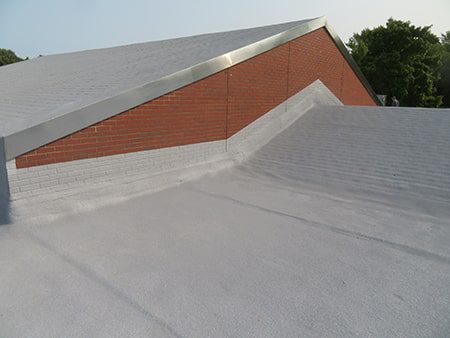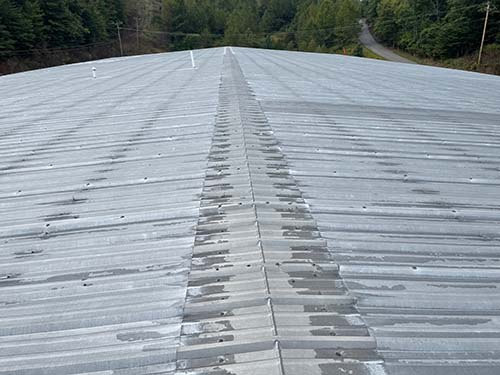So, you own commercial property and have roofing issues. Perhaps you have leaks, ponding or standing water, or an expired warranty.
And since you already know it’ll be an expensive problem to solve, you’re on the internet looking at ways to minimize those costs.
If this is you, this article is going to be perfect.
In this article, you’ll learn:
- The importance of getting an accurate assessment of wet insulation
- What are all the available roofing systems that I could install?
- What’s the typical installation cost, and what factors affect lifetime costs
- Characteristics of a trustworthy roofing contractor
And just so you’re aware, this article has been reviewed, edited, and approved for publishing by an internal commercial roofing specialist with more than 30 years of experience.
Let’s get started!
Tip #1 – Get an accurate assessment of wet insulation
Do you know how much of your roof’s insulation is wet?
This is important to know because if your roof is under 25% saturated, in some cases, you can remove and replace that 1-25%, and then install a new roofing system over the top.
A costly problem is not knowing how much wet insulation you have and automatically opting for a complete tear-off. Tear-off requires extensive labor hours, expensive landfill costs, and makes your project take longer.
Tip #2 – Know all of your options with available roofing systems
A costly mistake building owners make is assuming they need to replace their current roof with the roofing system they already have.
For example, if you have a rubber roof, you must remove and replace it with another rubber roof.
The same goes for metal roofs.
Indeed, this is an option, but there can be other, more cost-effective options.
For example, did you know that roof coating systems are very popular now because they can be installed over an existing roof? With the proper preparation, they can be installed over almost any type of roof. This can save you money versus a 100% tear-off and replacement.
The same can be said about spray foam roofing systems.
Spray foam can be installed over your existing roof as well. Besides avoiding the complete tear-off, there are many benefits of choosing a spray foam roof, including:
- A massive increase in R-value. This will reduce future energy costs
- Since the foam is fluid-applied, it will seal any crack, puncture, or water-entry point, even microscopic ones.
- Spray foam roofs are renewable. A foam roof will be the last roof ever needed on your building.
Long story short: don’t assume your only option is to replace your current roof with the same roof you already have. And don’t assume a 100% tear-off. There are roofing systems that can be installed over your existing roof, minimizing labor hours and landfill costs.
Tip #3 – Look at initial and lifetime costs
Cost is everything, right?
One problem building owners make is choosing their roofing system on the cost of the installation and nothing else.
But what about future costs?
If one roof costs $20,000, adds no R-value, and it’s hard to detect leaks (if there are any), does that compare equally to a roof that costs $25,000, adds an R-10 to the existing roof, and it’s easy to detect leaks (if there are any)?
Logically, no, they aren’t similar, but some property owners will only look at $20k vs. $25k, and that’s it.
Here are some things to think about when considering the lifetime costs of a roof:
R-value
R-value means energy efficiency. Suppose one roof is going to reduce your energy costs considerably, and one isn’t (or not as much). In that case, there will be a big difference in lifetime costs. Over 20 years, that’s 240 months. Even if you saved $100/month in energy costs, that’s $24,000 over 20 years.
Energy costs can be high for schools that require heat and cooling year-round or factories that require strict climate control. Any opportunity to reduce these costs can seriously impact your bottom line.
Renewability
Single-ply roofs have around a 20-year lifespan. If you want to install a new single-ply roof, you’ll most likely need to remove the old roof and put a new one on.
Silicone roof coating roofs can last 20 years as well. But at the 20-year mark, they can be renewed for ½ to 1/3 of the original cost. The coating naturally wears away over time.
How does this work?
When the coating is installed on day 1, and the building owner wants a 20-year warranty, the manufacturer of the coating knows that if 30 mils of coating are installed correctly, it’ll easily last 20 years.
Over 20 years, the 30 mils will naturally wear down, leaving approximately 7-8 mils left by year 20.
In year 21, the roofing contractor cleans the roof and installs a new 30 mil application. A new 20-year warranty is then granted.
TIP: When thinking long-term, think about roof renewability. Try to avoid a tear-off whenever possible.
Ease of repair/maintenance
Hopefully, you never have to repair your roof because it was installed correctly. However, every roof needs to be maintained. The NRCA (National Roofing Contractor’s Association) recommends having maintenance done in the Spring and Fall.
What happens during maintenance?
A visual inspection takes place to ensure the roof continues to drain correctly. Also, to ensure there are no water-entry points into the insulation below and to fix minor repairs to prevent them from worsening into larger repairs.
A problem that’s not widely considered is how easily this is done.
On roofs that are all one layer (seamless roofs), there are no fasteners, seams, or complicated materials used around penetrations. This makes roofing imperfections easy to identify.

The leak can be hard to identify on roofs that use fasteners and seams. Is this fastener allowing water in, or is it that one? Is this seam busted? Is the seam lifted a little bit here or there?

You get the idea.
Easy maintenance = fewer labor hours = less cost to the building owner.
With maintenance happening twice per year, for decade after decade, paying extra for maintenance can present a large number over time.
Likelihood of a leak
All roofing membranes can get cracks, punctures, and small holes. Flying debris, hail, etc., can cause them.
And when we talk about “membrane,” we’re talking about the most outer layer of a roof. The layer that the hail will hit. We aren’t talking about the insulation below the membrane.
But when hail creates a small opening, the insulation is exposed to water. This is where the type of insulation matters.
We’re talking about open-cell vs. closed-cell insulation.
Open-cell insulation, such as the widely used “poly-iso board,” when exposed to water, can become saturated. This is a problem because the board can keep getting more saturated, where the water moves down. When it gets to the bottom of the board, all that’s left is your roof deck. Water then comes into your building.
Closed-cell insulation, part of the spray foam roofing system, contains water and doesn’t allow it to travel down into the material. Water stays in the hole, and it will not move.

This is huge because even if the membrane gets damaged on a spray foam roof, it will not leak.
Tip #4 – Trust the roofing contractor
Repairing, restoring, or replacing a roof is a big investment. The last thing you want is to pay thousands for a roof, it’s installed wrong, and you have a leak in a few months.
Therefore, the installation needs to be premium!
Here are some questions that will help you choose a trustworthy contractor:
How long have they been in business?
A company that’s been around for a long time has a track record of good work. If they are a newer company, do they do good work or not? Without any history, you really have no idea.
Will they be around when the 20-year warranty expires?
If you get a 10-20-year warranty, are you confident that the contractor will be around for the length of it? A company with longevity increases the likelihood that they will be around for the entire warranty.
Do they offer manufacturer warranties?
One way a building owner can keep their warranty, regardless of the roofing contractor’s status, is to get a manufacturer’s warranty. Suppose the roofing contractor goes out of business. In that case, another contractor in the manufacturers’ network will be assigned to take it over.
But being a certified installer of a manufacturer isn’t easy to obtain. A sign of a trustworthy contractor is one that’s certified with multiple manufacturers to install their products.
The contractor has been trained to install their products correctly so the materials last (and usually greatly exceed) the warranty period.
Do they have a full-time service team?
Remember when I said your roof will need to be maintained twice per year? The question is, who’s going to do it? Some roofing contractors have a full-time service team that only does this type of work.
Some contractors don’t have a dedicated service team and just take a guy off a job to quickly service your roof.
There’s a big difference in quality when you have a dedicated service team, as they will have a history with your roof. They will know the areas of high risk to look out for. They will know what repairs were made last time and pay extra attention to those areas. They will know what areas were highlighted in previous service appointments to keep an eye on.
Do they have a list of clients who were in similar situations you were in many years ago?
Say you have a large metal roof that’s leaking. A contractor proposes to save the tear-off and install a roof coating system. Does the contractor have a similar-sized metal roof in their portfolio that was coated 5-10 years ago?
If so, ask to take a trip and walk the roof. See how it looks today.
This will give you confidence that the proposed solution will work for you just like it did for someone else 5-10 years ago.
Conclusion
Hopefully, today, you learned that you need to master four things to make the best cost-effective decision with your commercial roof. They are:
- Know how much saturated insulation you have. Knowing this opens or closes many roofing options.
- Know all the possible roofing systems that are available. You don’t automatically need to go with TPO because you already have a TPO roof.
- Know the installation costs of your roof, but also factor in lifetime costs when making your decision.
- You need to trust that the contractor will install a great roof on day 1. Then you need to be sure they will be around to maintain your roof for the length of the warranty.

